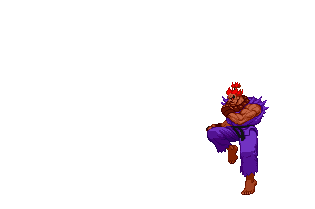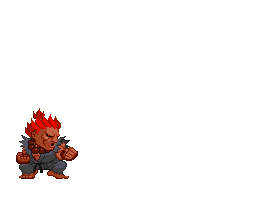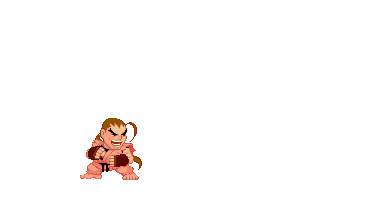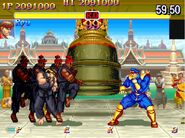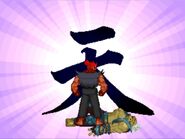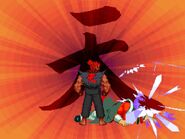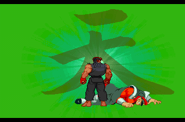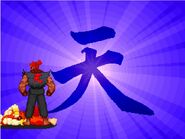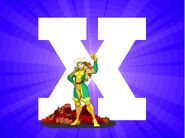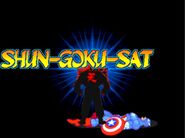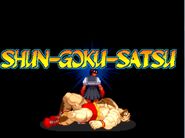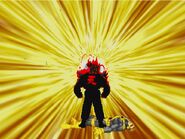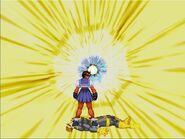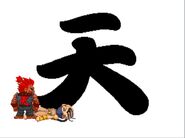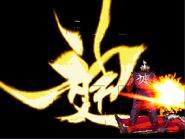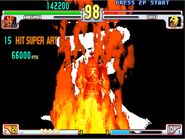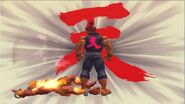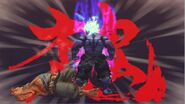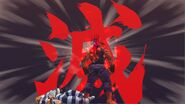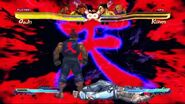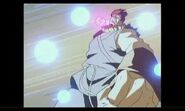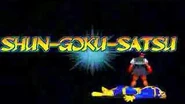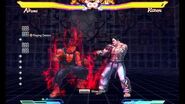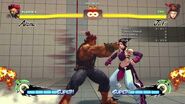- "The Raging Demon... It's power is unequaled... It is not my fist but your past sins that will kill you... The more evil your past doings, the more painful your death..."
- —Akuma to M. Bison in Street Fighter Alpha 3
- "Die!
Messatsu! / Your time has run out.
(滅せよ!
滅・・・殺! / 終焉の時なり・・・
Messeyo!
Mes...satsu! / Shuuen no toki nari...?)" - —Oni
The Raging Demon (瞬獄殺 Shun Goku Satsu?, "Instant Prison Murder" or "Blinking Prison Killer") is a special attack commonly seen in the Street Fighter games. Super Street Fighter II Turbo featured the first appearance of this attack, though it was not its first usable appearance; Akuma's introduction has him perform the attack on Bison just as he is about to face the player (it becomes Akuma's Super Combo in later versions of the game[1]).
The Raging Demon first became Akuma's trademark Super Combo in the Street Fighter Alpha series.
In the games
| Appearance | User(s) | Function | Input |
|---|---|---|---|
| Super Street Fighter II Turbo Revival Super Street Fighter II Turbo: HD Remix |
Akuma | Super Combo | |
| Street Fighter Alpha series Street Fighter EX Capcom vs. SNK series |
Akuma Evil Ryu |
Super Combo | |
| Street Fighter III series | Akuma | Super Art | |
| Marvel vs. Capcom series (except Marvel vs. Capcom 3) |
Akuma Ryu (Complete Change) Sakura (as Dark Sakura) |
Hyper Combo | |
| Marvel vs. Capcom 3 | Akuma | Hyper Combo | |
| Super Gem Fighter Mini Mix | Akuma | Mighty Combo | |
| Street Fighter EX3 | Evil Ryu | Meteor Combo | |
| SNK vs. Capcom: The Match of the Millennium | Akuma Evil Ryu Sakura (Master Skill) |
Super Combo | |
| SVC Chaos: SNK vs. Capcom | Akuma | EXCEED | |
| SVC Chaos: SNK vs. Capcom | Shin Akuma | Super Combo | |
| Street Fighter IV series | Akuma Evil Ryu Oni |
Super Combo | |
| Street Fighter IV series | Akuma | Ultra Combo | |
| Street Fighter X Tekken | Akuma | Super Art |
Description
Executed often by pressing light punch twice, forward, light kick and then heavy punch, the user glides towards the opponent and grabs them. Before anything else can be seen, the screen blacks out (or turns completely blank white in some game incarnations) as the character is relentlessly beaten, as showcased by a series of flashes.
In Super Street Fighter II Turbo Revival, the move has an unusual property: the move can be executed with any kick button available, meaning that as long as the player inputs it normally with the kick, the move will be executed and performed by both Akuma and Shin Akuma.
The move often appears as Akuma's most powerful, and sometimes 'secret', Super Combo. In Street Fighter III: 2nd Impact, it appears as his secret Super Art, and one of two secret Super Arts in Street Fighter III: 3rd Strike. He can use it in a match no matter what Super Art had been selected, thus giving him access to more than one Super Art at any given time.
Though the move is normally associated with Akuma and his various forms (e.g. Shin Akuma), Ryu has been able to use it as well when he is fully under the influence of the Satsui no Hado. Several other users have emerged over the years, and the move's popularity has caused it to be referenced in several other forms of media within and outside the series.
Street Fighter IV series
The Street Fighter IV games introduce another, more powerful variant of the Raging Demon as Akuma's first Ultra Combo. It has been "given" most of the original attack's properties: the Wrath of the Raging Demon possesses startup invincibility that is also common with Ultra Combos, and deals several more hits and extremely high damage in comparison.
Tactics
In earlier installments, the Raging Demon usually can be comboed into via a standing jab or a standing roundhouse, as well as cancelling a slower move. Like most high-powered moves in the Street Fighter IV, Focus Attacks can also provide an opening. Despite its power, however, characters can escape with longer-ranged moves, due to the actual grab being close-range. It can also be countered with as little as a quick jab or, punished with a retreating jump attack.
For Akuma players, a well-placed Zanku Hadoken can give the user enough time to input it while the opponent is defenseless.
Advanced tactics
Starting with the Street Fighter III series, a popular strategy uses a "kara" (void) throw-type of whiff to extend the move's range, or to bait the opponent into a frame trap of some sort.
Storyline Info
In the storyline, the Raging Demon is a very powerful, but fatally dangerous technique taught in the original principles of Ansatsuken by Goutetsu. When performed, the user of the Satsui no Hado would rage out of control, turning them into a bloodthirsty berserker that rampages until their opponent's death, and even their own if the user's body is not prepared.
As this move usually defeats the opponent instantly or kills them, the basis of the attack is said to be linked to karmic forces drawn from the influence of the Satsui no Hado, channeling an infernal punishment in which the weight of sins and evil the victim has committed destroys their soul. While immensely powerful, this attack cannot work on artificial life forms or people who lack souls, and it is often through the latter method that some characters have survived its wrath.
- Gen managed to withstand the attack by emptying his soul in time before it could consume him, but it took a lot of power to do so.
- M. Bison was able to survive the move at the end of Super Street Fighter II Turbo, because he kept a portion of his life force and soul within Rose, which allowed him to come back in Street Fighter IV.
- Gouken, Akuma's brother, has also survived, due to his embrace to "emptiness" within his fighting style. It was most likely that Gouken performed a soul evacuation much like Gen, but did not completely succeed, resulting in him lapsing into a comatose state.
In Evil Ryu's Street Fighter Alpha 3 storyline, in the intro to his final boss battle, he counters Shin Akuma's Raging Demon with his own, cancelling both attacks. The tactics was also displayed in his fight against Asura in the Asura's Wrath DLC Lost Episode 1: At Last, Someone Angrier Than Me.
In the Street Fighter III series, Gill faced a Raging Demon head on, but because of his Resurrection ability, he survived the encounter.
Known Users
- Akuma is the first and most known user. It is his trademark move, as his Super and Ultra Combo. His kanji is "heaven" (天 ten?). When he becomes Shin Akuma in Capcom vs. SNK 2, his kanji becomes "godlike person" (神人 shinjin?).
- SNK character Rugal Bernstein shares Akuma's kanji after he absorbs the Satsui no Hado from Akuma in Capcom vs. SNK 2, although his is a dark red compared to Akuma's bright orange. Also, in one of his win animation, he rips his shirt, revealing a glowing red 天 kanji on his chest.
- Evil Ryu has it as his Super Combo. His kanji is "destruction" (滅 metsu?).
- Asura, from Capcom's Asura's Wrath, was seen using this move to counter Evil Ryu's in the Lost Episode DLC of the game. His kanji stands for "wrath" or "anger" (怒 ikari?).
- It is also Oni's Super Combo. His kanji is an amalgation of "god" (神 kami?) and "demon" (鬼 oni?), and can be interpreted as "demon god" or "worshipping the demon" (鬼神 kishin?), or just the kanji "soul" (魂 kon?).
- In Super Gem Fighter Mini Mix, Dan's father is summoned by his son and performs this move. His kanji is "father" (父 chichi?).
- Rogue from Marvel Comics' X-Men can use this as a Hyper Combo in X-Men vs. Street Fighter. Her sign is the titular "X".
- Sakura has this move as her Hyper Combo in Marvel Super Heroes vs. Street Fighter. No kanji has been shown.
- Yuri Sakazaki, from the Art of Fighting series, uses a similar move in King of Fighting 2001; the animation is shorter, but the inputs are the same.[2]
Concept

The infamous animation of the Raging Demon.
In the religion of Buddhism, there are said to be sixteen hells - eight of fire and eight of ice - where the depraved and damned are said to be punished in, referenced by the 16 hits (and/or hit sparks) the move usually does; in some games (e.g. the Street Fighter III series) the move does 15 hits in total, with a KO producing a fiery backdrop, nodding to the final hell of fire.
In addition, the appearance of the "heaven" kanji, characteristically associated with its user Akuma, and how the move's style is that of assassination, is likely a reference to the Japanese word tenchu, meaning "heavenly retribution", which was a popular memento written on paper by assassins to their victims and associates in Feudal and turbulent eras of Japan. This concept is referenced by http://megaman.wikia.com/wiki/Ciel Ciel] when Zero faces off against Akuma in SNK vs. Capcom: SVC Chaos, describing Akuma as if he is an actual assassin.
Visual Depictions
In Gouken's ending in Street Fighter IV, the Raging Demon is shown as a mighty punch enveloped in crimson energy. The Street Fighter US animated series predated and used this exact depiction, though the energy was violet-colored.
It makes its first ever CG appearance as well in Steve Fox and Hwoarang's ending of Street Fighter X Tekken; the latter brags that he could have easily beaten one hundred opponents without breaking a sweat, and Pandora grants this by summoning one hundred Akumas, all of whom perform the Raging Demon attack at once.
The move made its second CG appearance in Asura's Wrath DLC, Lost Episode 1: At Last, Someone Angrier Than Me; Evil Ryu and Asura used it on each other, but both are seen standing after the successful quick-time event, inferring the conclusion that the moves canceled each other blow for blow. In Lost Episode 2: The Strongest vs. The Angriest, Oni attempts to use the Raging Demon, but is interrupted and countered, resulting in Oni flying into the air.
The move makes its first cinematic appearance in Episode 9 of Street Fighter: Assassin's Fist when Akuma uses it to kill his master, Goutetsu. As the latter charges up an extremely powerful Metsu Hadoken, Akuma engulfs himself in a mass of red flames, zooming at high speed towards Goutetsu and passing through the Hadoken. Little of the move is seen, though as Goutetsu is grabbed, a bright flash can be seen, right before the shot changes and a harrowing scream can be heard echoing along with the familiar screech. As Akuma stands over his fallen master, the kanji for "heaven" (天, ten) can be seen not only burning bright on his back but also in the thundery clouds above.
Trivia
- In Super Gem Fighter Mini Mix, Akuma's Raging Demon Mighty Combo has two different animations: the first is the traditional unseen assault, while in the second Akuma is shown striking the opponent in different places as the screen flashes with each hit. The second animation will only be seen if Akuma throws a punch first, and the movement to execute the super combo as the immediate follow-up. Also, if one looks carefully, at certain points Akuma can be seen posing at the "camera" while wearing swimming trunks and goggles.
- With the exception of Sakura[3], every user's own personal kanji is shown after successfully performing the technique.
- In the original Street Fighter RPG game, the Raging Demon and its user, Akuma, don't exist. Still, fans of the game developed a version of the attack at "Street Fighter RPG Brasil".[4]

